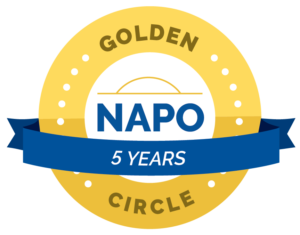Things can be so dog-gone overwhelming sometimes, can’t they?
I worked with a couple clients last week that were paralyzed by their “to do” lists. The lists were so long and the projects were so daunting that the default action was inaction.
They were trying to work with boulders when it would have been much easier to work with pebbles.
What does working with boulders vs pebbles mean? I’ll use one of my projects as an example.
I realized that my current business name doesn’t speak to a large segment of my business: coaching. If you were looking for a coach would you think it made sense to contact “Organize to Simplify?” I know I wouldn’t, so I’m changing my business name which triggers a plethora of tasks. Some of these are Boulder tasks, some are pebble tasks.
Change business name and identity: Boulder task
- Secure new domain: Pebble task
- Create new logo: Boulder task
- Create a new website: Boulder task
- Outreach to clients and support base: Boulder task
Secure new domain: Pebble task (done)
Create new logo: Boulder task
- Hire designer: Pebble task (done)
- Engage with friends, family, and colleagues for their input on initial designs: Pebble task (done)
- Submit preference to the designer: Pebble ask
- Review 2nd round submissions, review updates with the designer: Pebble task
- Review 3rd round submissions, review updates with the designer: Pebble task
Create a new website: Boulder task
- Decide on new website platform: Boulder task (done)
- Review website options and costs: Pebble task (done)
- Review website templates: Pebble task (done)
- Determine if the website will be self-created or hire sub-contractor: Boulder task
- Determine if I can do it myself: Pebble task
- Determine if I can justify sub-contractor cost: Pebble task
- Determine timeline availability of sub-contractor matches desired deliverable: Pebble task
- Create website sitemap: Pebble task
- Rewrite website pages: Pebble task
- Choose images for the website: Pebble task
Market new company: Boulder task
- Create marketing plan: Boulder task
- Determine marketing target: Pebble task
- Determine marketing vehicles: Pebble task
- Order new business cards and note cards: Pebble task
- Write a letter of introduction to clients and support base: Pebble task
- Solicit LinkedIn endorsements: Pebble task
- Solicit Google My Business endorsements: Pebble task
I fid this to be a pretty daunting, and I’m certain incomplete, list.
The task of “Change business name and identity” is a boulder task. I would never have been able to pick that boulder up all at one time. The boulder task was too big. I needed to create many pebbles out of that boulder in order to be successful.
What boulder tasks are you avoiding because they are too daunting?
What could you get done if you broke that boulder into pebbles?
Cindy Jobs, COC, ACC
Looking for more information?
Click here for 15-minute organizing tips.
National Association of Productivity & Organizing Professionals, Seattle Chapter Vice-President
International Coach Federation
Institute for Challenging Disorganization
Level I Certificates earned in Chronic Disorganization; ADD; Client Administration; Time Management; Mental Health; and Hoarding.
Level II Specialist Certificates earned in Chronic Disorganization and ADHD
















